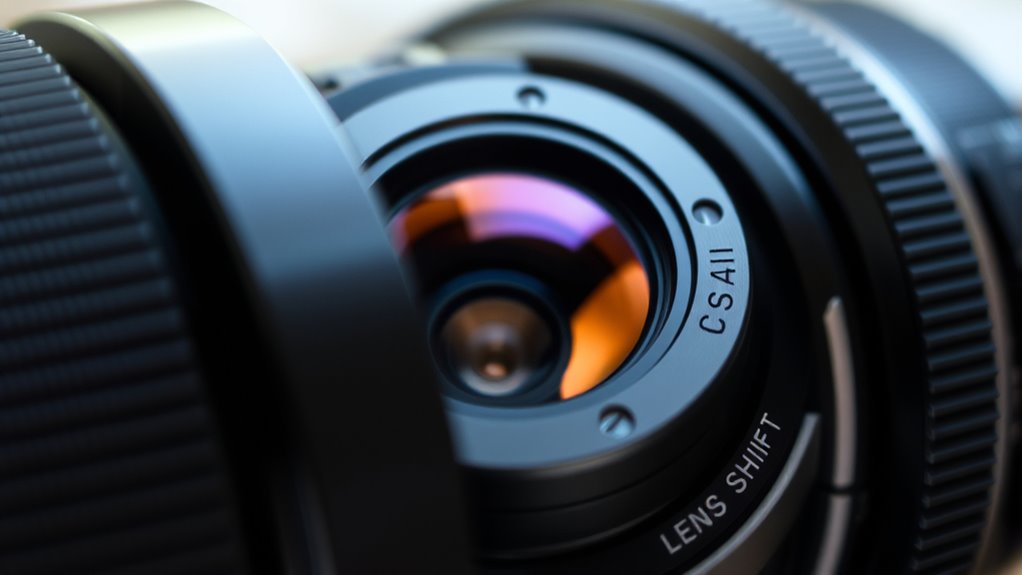Lens shift lets you adjust your projector’s image position without moving the device or causing distortion. It moves the lens vertically, horizontally, or both, maintaining proper alignment and sharpness. This feature helps you perfectly position the image on your screen while avoiding issues like keystone distortion or blurry edges. By using lens shift, you keep the picture clear and true to the original. Keep going to uncover more about how this simple adjustment improves your viewing experience.
Key Takeaways
- Lens shift allows precise adjustment of the projector’s lens position to move the image without physically repositioning the device.
- It maintains proper optical alignment, preventing keystone distortion and ensuring a correctly proportioned, sharp image.
- Using lens shift avoids digital correction methods that can cause resolution loss or image artifacts.
- This feature enables fine-tuning image placement for optimal viewing without compromising picture quality.
- Lens shift provides flexible setup options, simplifying installation and improving overall image accuracy and clarity.

Lens shift is a feature that allows you to adjust the position of a projector’s lens without moving the entire device. This capability is especially useful when you want to fine-tune your image placement on the screen without altering its size or aspect ratio. By shifting the lens vertically or horizontally, you can precisely control where the image appears, making setup easier and more flexible. This adjustment helps you avoid having to reposition your projector physically, which can be inconvenient or impossible in tight spaces.
Lens shift lets you fine-tune your projector’s image placement without moving the device, making setup quick and flexible.
When you use lens shift, it’s essential to understand its role in maintaining proper optical alignment. Optical alignment ensures that the projected image remains sharp, correctly proportioned, and free from keystone distortion or skewed edges. If the lens isn’t properly aligned, the image can become distorted or blurry, undermining your viewing experience. Lens shift allows you to keep the optical path properly aligned without sacrificing image quality, so you can achieve a clear, well-positioned picture every time.
Furthermore, lens shift plays a significant role in image calibration. Calibration involves adjusting various settings to optimize the image quality and position. When you utilize lens shift during calibration, you can fine-tune the image’s placement to match your screen perfectly. This process helps you avoid the need for keystone corrections or digital warping, which can degrade picture quality. Instead, you can rely on the physical adjustment of the lens to achieve a natural, distortion-free image. This makes your setup more straightforward and ensures that your picture remains sharp and true to the original content.
Another advantage of lens shift is that it preserves the integrity of your image during adjustments. Unlike digital keystone correction, which can reduce resolution and detail, lens shift maintains the original quality of the projected image. As a result, you get a high-quality picture that’s free from artifacts or pixelation caused by digital adjustments. This feature is particularly valuable in professional settings, home theaters, or classrooms where image clarity is critical. Additionally, understanding popular projection features like lens shift can help you select the right device for your needs, ensuring optimal performance and image quality.
Frequently Asked Questions
Can Lens Shift Affect Overall Image Brightness?
Lens shift can slightly affect overall image brightness, but the impact is usually minimal. When you adjust the lens position, it might cause a small decrease in brightness, which could influence image clarity if not compensated for. However, most projectors allow for brightness adjustments to maintain ideal image quality. So, while there’s a slight brightness impact, it generally doesn’t considerably compromise your viewing experience or image clarity.
Is Lens Shift Compatible With All Types of Projectors?
Think of lens shift as the secret handshake of projectors—offering you mounting flexibility, but not everyone’s invited. Not all projectors are compatible because their internal design and installation considerations vary. Before you start, check your projector’s specifications to see if it supports lens shift. This feature is a handy tool, but it’s essential to verify your setup aligns with your projector’s capabilities for a seamless, distortion-free picture.
How Does Lens Shift Impact Image Keystone Correction?
Lens shift helps you maintain keystone preservation and perfect image alignment without needing digital keystone correction. By physically moving the lens, you avoid distortion and keep the image rectangular, unlike with electronic adjustments that can degrade quality. This means your image stays sharp, and the setup is more straightforward. You’ll appreciate how lens shift allows for precise positioning, reducing the need for other correction methods, and delivering a cleaner, more professional picture.
Are There Any Maintenance Tips for Lens Shift Mechanisms?
To keep your lens shift mechanism working smoothly, regularly perform alignment maintenance by checking for any misalignment or stiffness. Lubrication procedures are essential; use a small amount of appropriate lubricant on the moving parts to prevent squeaking and guarantee smooth adjustments. Avoid over-lubricating, and keep the mechanism clean from dust and debris. Proper maintenance helps extend the lifespan of your lens shift system and maintains ideal image positioning.
Can Lens Shift Be Used During Live Presentations?
Yes, you can use lens shift during live presentations. It offers mounting flexibility and setup convenience, allowing you to fine-tune the image position without moving the projector. Simply adjust the lens shift mechanism to align the image perfectly on your screen. This feature helps you quickly adapt to different room setups, ensuring your presentation looks professional without interrupting or disrupting the flow.
Conclusion
Think of lens shift as steering a boat smoothly across still waters—you can adjust your view without rocking the entire scene. By mastering this feature, you’re in control of your projected image, ensuring it stays perfectly aligned without distortion. So, next time your picture isn’t quite right, remember that lens shift is your silent navigator, helping you steer your display to perfection effortlessly. With this tool, your viewing experience becomes as seamless as a calm, guided journey.









